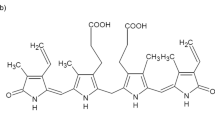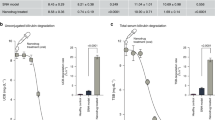Abstract
Background:
Hazardous levels of bilirubin produce oxidative stress in vitro and may play a role in the genesis of bilirubin-induced neurologic dysfunction (BIND). We hypothesized that the antioxidants taurourosdeoxycholic acid (TUDCA), 12S-hydroxy-1,12-pyrazolinominocycline (PMIN), and minocycline (MNC) inhibit oxidative stress and block BIND in hyperbilirubinemic j/j Gunn rat pups that were given sulfadimethoxine to induce bilirubin encephalopathy.
Methods:
At peak postnatal hyperbilirubinemia, j/j Gunn rat pups were dosed with sulfadimethoxine to induce bilirubin encephalopathy. Pups were given TUDCA, PMIN, MNC, or vehicle pretreatment (15 min before sulfadimethoxine). After 24 h, BIND was scored by using a rating scale of neurobehavior and cerebellar tissue 4-hydroxynonenal and protein carbonyl dinitrophenyl content were determined. Nonjaundiced heterozygous N/j pups served as controls.
Results:
Administration of sulfadimethoxine induced BIND and lipid peroxidation but not protein oxidation in hyperbilirubinemic j/j pups. TUDCA, PMIN, and MNC each reduced lipid peroxidation to basal levels observed in nonjaundiced N/j controls, but only MNC prevented BIND.
Conclusion:
These findings show that lipid peroxidation inhibition alone is not sufficient to prevent BIND. We speculate that the neuroprotective efficacy of MNC against BIND involves action(s) independent of, or in addition to, its antioxidant effects.
Similar content being viewed by others
Log in or create a free account to read this content
Gain free access to this article, as well as selected content from this journal and more on nature.com
or
References
Watchko JF . Kernicterus and the molecular mechanisms of bilirubin-induced CNS injury in newborns. Neuromolecular Med 2006;8:513–29.
Brito MA, Brites D, Butterfield DA . A link between hyperbilirubinemia, oxidative stress and injury to neocortical synaptosomes. Brain Res 2004;1026:33–43.
Brito MA, Lima S, Fernandes A, et al. Bilirubin injury to neurons: contribution of oxidative stress and rescue by glycoursodeoxycholic acid. Neurotoxicology 2008;29:259–69.
Brito MA, Rosa AI, Falcão AS, et al. Unconjugated bilirubin differentially affects the redox status of neuronal and astroglial cells. Neurobiol Dis 2008;29:30–40.
Park WS, Chang YS, Lee M . Effect of 7-nitroindazole on bilirubin-induced changes in brain cell membrane function and energy metabolism in newborn piglets. Biol Neonate 2002;82:61–5.
Fernandes A, Vaz AR, Falcão AS, Silva RF, Brito MA, Brites D . Glycoursodeoxycholic acid and interleukin-10 modulate the reactivity of rat cortical astrocytes to unconjugated bilirubin. J Neuropathol Exp Neurol 2007;66:789–98.
Silva RF, Rodrigues CM, Brites D . Bilirubin-induced apoptosis in cultured rat neural cells is aggravated by chenodeoxycholic acid but prevented by ursodeoxycholic acid. J Hepatol 2001;34:402–8.
Lertvorachon J, Kim JP, Soldatov DV, et al. 1,12-substituted tetracyclines as antioxidant agents. Bioorg Med Chem 2005;13:4627–37.
Kraus RL, Pasieczny R, Lariosa-Willingham K, Turner MS, Jiang A, Trauger JW . Antioxidant properties of minocycline: neuroprotection in an oxidative stress assay and direct radical-scavenging activity. J Neurochem 2005;94:819–27.
Lin S, Wei X, Bales KR, et al. Minocycline blocks bilirubin neurotoxicity and prevents hyperbilirubinemia-induced cerebellar hypoplasia in the Gunn rat. Eur J Neurosci 2005;22:21–7.
Geiger AS, Rice AC, Shapiro SM . Minocycline blocks acute bilirubin-induced neurological dysfunction in jaundiced Gunn rats. Neonatology 2007;92:219–26.
Rodrigues CM, Solá S, Brito MA, Brondino CD, Brites D, Moura JJ . Amyloid beta-peptide disrupts mitochondrial membrane lipid and protein structure: protective role of tauroursodeoxycholate. Biochem Biophys Res Commun 2001;281:468–74.
Plane JM, Shen Y, Pleasure DE, Deng W . Prospects for minocycline neuroprotection. Arch Neurol 2010;67:1442–8.
Bastos LF, Angusti A, Vilaça MC, et al. A novel non-antibacterial, non-chelating hydroxypyrazoline derivative of minocycline inhibits nociception and oedema in mice. Br J Pharmacol 2008;155:714–21.
Rodrigues CM, Sola S, Nan Z, et al. Tauroursodeoxycholic acid reduces apoptosis and protects again neurological injury after acute hemorrhagic stroke in rats. Proc Natl Acad Sci USA 2003;100:6087–92.
Rodrigues CM, Steer CJ . The therapeutic effects of ursodeoxycholic acid as an anti-apoptotic agent. Expert Opin Investig Drugs 2001;10:1243–53.
Silva RF, Rodrigues CM, Brites D . Rat cultured neuronal and glial cells respond differently to toxicity of unconjugated bilirubin. Pediatr Res 2002;51:535–41.
Barreto GE, Gonzalez J, Torres Y, Morales L . Astrocytic-neuronal crosstalk: implications for neuroprotection from brain injury. Neurosci Res 2011;71:107–13.
McDonagh AF . Is bilirubin good for you? Clin Perinatol 1990;17:359–69.
Hayes JD, McLellan LI . Glutathione and glutathione-dependent enzymes represent a co-ordinately regulated defense against oxidative stress. Free Rad Res 1999;31:273–300.
Daood MJ, Watchko JF . Calculated in vivo free bilirubin levels in the central nervous system of Gunn rat pups. Pediatr Res 2006;60:44–9.
Roy-Chowdhury J, Huang TJ, Kesari K, Lederstein M, Arias IM, Roy-Chowdhury N . Molecular basis for the lack of bilirubin-specific and 3-methylcholanthrene-inducible UDP-glucuronosyltransferase activities in Gunn rats. The two isoforms are encoded by distinct mRNA species that share an identical single base deletion. J Biol Chem 1991; 266:18294–8.
Johnson L, Garcia ML, Figueroa E, Sarmiento F . Kernicterus in rats lacking glucuronyl transferase. II. Factors which alter bilirubin concentration and frequency of kernicterus. Am J Dis Child 1961;101:322–49.
Blanc WA, Johnson L . Studies on kernicterus; relationship with sulfonamide intoxication, report on kernicterus in rats with glucuronyl transferase deficiency and review of pathogenesis. J Neuropathol Exp Neurol 1959;18:165–87; discussion 187–9.
Schutta HS, Johnson L . Clinical signs and morphologic abnormalities in Gunn rats treated with sulfadimethoxine. J Pediatr 1969;75:1070–9.
Cannon C, Daood MJ, O’Day TL, Watchko JF . Sex-specific regional brain bilirubin content in hyperbilirubinemic Gunn rat pups. Biol Neonate 2006;90:40–5.
Chaniary KD, Baron MS, Rice AC, Wetzel PA, Ramakrishnan V, Shapiro SM . Quantification of gait in dystonic Gunn rats. J Neurosci Methods 2009;180:273–7.
Schutta HS, Johnson L . Bilirubin encephalopathy in the Gunn rat: a fine structure study of the cerebellar cortex. J Neuropathol Exp Neurol 1967;26:377–96.
Colovic M Caccia S . Liquid chromographic determination of minocycline in brain-to-plasma distribution studies in the rat. J Chromatogr [B] 2003;791:337–43.
Keene CD, Rodrigues CM, Eich T, et al. A bile acid protects against motor and cognitive deficits and reduces striatal degeneration in the 3-nitropropionic acid model of Huntington’s disease. Exp Neurol 2001;171:351–60.
Oveson BC, Iwase T, Hackett SF, et al. Constituents of bile, bilirubin and TUDCA, protect against oxidative stress-induced retinal degeneration. J Neurochem 2011;116:144–53.
Colak A, Kelten B, Sagmanligil A, et al. Tauroursodeoxycholic acid and secondary damage after spinal cord injury in rats. J Clin Neurosci 2008;15:665–71.
Rodrigues CM, Solá S, Silva R, Brites D . Bilirubin and amyloid-β peptide induce cytochrome c release through mitochondrial membrane permeabilization. Mol Med 2000;6:936–46.
Martinek RG . Improved micro-method for determination of serum bilirubin. Clin Chim Acta 1966;13:161–70.
Uchida K . 4-Hydroxy-2-nonenal: a product and mediator of oxidative stress. Prog Lipid Res 2003;42:318–43.
Harris RA, Amor S . Sweet and sour–oxidative and carbonyl stress in neurological disorders. CNS Neurol Disord Drug Targets 2011;10:82–107.
Bruce-Keller AJ, Li YJ, Lovell MA, et al. 4-Hydroxynonenal, a product of lipid peroxidation, damages cholinergic neurons and impairs visuospatial memory in rats. J Neuropathol Exp Neurol 1998;57:257–67.
Acknowledgements
PMIN was provided to the project by Yasuo Konishi and Jean-Manuel Cloarec of the Biotechnology Research Institute, National Research Council Canada, Montreal, Quebec, Canada.
Author information
Authors and Affiliations
Corresponding author
Rights and permissions
About this article
Cite this article
Daood, M., Hoyson, M. & Watchko, J. Lipid peroxidation is not the primary mechanism of bilirubin-induced neurologic dysfunction in jaundiced Gunn rat pups. Pediatr Res 72, 455–459 (2012). https://doi.org/10.1038/pr.2012.111
Received:
Accepted:
Published:
Issue date:
DOI: https://doi.org/10.1038/pr.2012.111
This article is cited by
-
Molecular events in brain bilirubin toxicity revisited
Pediatric Research (2024)
-
Models of bilirubin neurological damage: lessons learned and new challenges
Pediatric Research (2022)
-
Normalizing hyperactivity of the Gunn rat with bilirubin-induced neurological disorders via ketanserin
Pediatric Research (2022)
-
Bilirubin inhibits lipid raft dependent functions of L1 cell adhesion molecule in rat pup cerebellar granule neurons
Pediatric Research (2021)
-
Inflammatory signature of cerebellar neurodegeneration during neonatal hyperbilirubinemia in Ugt1 -/- mouse model
Journal of Neuroinflammation (2017)



